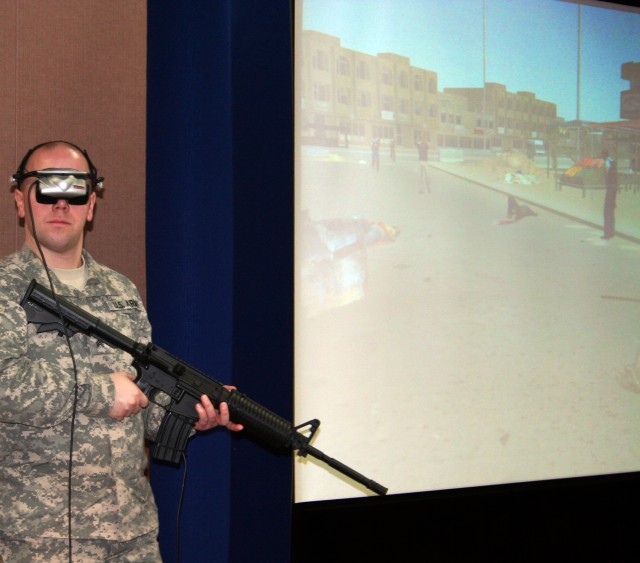
FORT LEWIS, Wash. (Jan. 19, 2010) -- This summer, thousands of Joint Base Lewis-McChord Soldiers will return home from deployments to Iraq and Afghanistan, ready to reunite with family and loved ones. But for some, the war will not be over.
The Improvised Explosive Device that killed their best friend while on a mission will play over and over again in a few Soldiers' minds. For others, who may have just finished up their third or fourth deployment in less than a decade, may recall traumatic events and describe them with little or no emotion, similar to giving results for an after-action review.
Behavioral health providers have treatment options for Soldiers dealing with these serious examples of Post Traumatic Stress Disorder, but one in particular is receiving lots of attention in the medical community - Virtual Reality Exposure Therapy.
The Department of Defense National Center for Telehealth and Technology, in partnership with the Defenses Center of Excellence for Psychological Health and Traumatic Brain Injury, and the Department of Psychology at Madigan, were funded by the United States Army Medical Research and Materiel Command, to conduct a four-year study to determine the effectiveness of VRET on active-duty servicemembers returning from Operations Iraqi Freedom and Enduring Freedom who are suffering from PTSD.
Through VRET, behavioral health providers can use 360-degree, interactive computer-generated environments uniquely tailored to expose the patients back into the environment and experience where the trauma occurred, to help reduce anxiety and post-traumatic stress.
The congressionally-funded medical research study is the first randomized clinical trial that uses active-duty military diagnosed with combat-related PTSD to compare VRET results to traditional "imaginal" prolonged exposure therapy, and to a control group that waits five weeks for any type of treatment.
The study's sample size is 120 servicemembers to complete the three types of treatment options. Treatment sessions for each type of therapy last about 90 minutes, said Dr. Greg Reger, the chief of T2's Innovative Technology Applications division. And the best way to participate in the study is to be recommended by a behavioral health specialist at Madigan Healthcare System or Naval Hospital Bremerton.
Established prolonged exposure requires a person to imagine, in as much detail as possible, the traumatic situation and describe the image or memory verbally. This treatment is repeated by the patient over and over again, until the stress is reduced. It is currently the technique most used by clinicians throughout the Department of Defense. However, Reger said "imaginal" exposure is less effective for combat trauma than other types of trauma.
He linked the lowered success rate to Soldiers, for example, having to endure multiple deployments for 12 to 15 months at a time. Some people find it difficult to imagine in sufficient detail or for a long enough period of time to reduce anxiety, he said. "With a constant stressful environment and exposure to potentially multiple traumatic events, people get emotional disengagement," Reger said.
VRET is traditionally used to treat phobias like fear of heights or flying, in a cost-effective manner, Reger added.
"I can't fly a patient in a plane to create the exposure, but I can use a computer flight simulator and get the same effect," he said.
Patients undergoing VRET still explain to the therapist what happened that caused the trauma, but are exposed to a variety of computer-generated stimuli with the program "Virtual Iraq." VRET is designed to promote a multi-sensory emotional connection to the memory, thus helping the patient be able to gradually face the traumatic experiences that underlie his or her distressing memories after a number of treatment sessions.
This connection is facilitated by having the patient put on a head-mounted display (over-the-eyes video glasses) and either ride or drive in a simulated convoy, and Reger matches the scenario to the event. Or a Soldier will be given a dummy M-4 with a mounted game controller and conduct a dismounted patrol, and Reger could simulate gunfire.
Reger can customize the simulation experience ensuring ample control of the exposure to the programmed situations - changing weather conditions, terrain, helicopter flyovers, types of attack; even add in Muslim prayer call.
"Consider the difference between someone closing his eyes and imagining the situation versus someone who tells his story while the same type of event is occurring with the sights and sounds - it is so much more emotionally-engaging," Reger said.
Reger encourages those who are suffering from PTSD to give the study a try, because he said it is his job to give back to those who have already sacrificed so much.
"We have treatments that are effective; and we can help get our troops back to the level of functioning their families need them to be in," Reger said.
The DoD is expanding its use of VRET treatments. Walter Reed Army Medical Center in Washington, D.C., and the Naval Medical Center San Diego are conducting their own VRET-based studies; Tripler Army Medical Center in Hawaii and a number of Veterans Affairs hospitals are starting to use virtual reality, as more servicemembers transition into veterans.
"Exposure therapy is a well-established therapy and a great way to leverage treatment with technology," Reger said.
(For more information on the VRET study, call (253) 968-4793)

Social Sharing